Mounds
There are two very large pyramid-shaped mounds: "Moxeke" and "Huaca A", 1.3 km apart. They are aligned precisely to N 41° E. In the vicinity, there are also scattered more than 100 small mound structures aligned with the main mounds. The whole site covers about 2 km2. [2]
The site also contains the remains of many other buildings, including the administrative buildings, and groups of residences of different sizes.
Moxeke, the main mound, is a stepped pyramid containing at least six platforms. It was about 30 m in height, and almost quadrangular: about 160 by 170 m. It was built from megalithic stones, also using conical adobe bricks.
The Pozorskis also found some evidence that there was still earlier construction on the site. [3]

Tiwanaku is a Pre-Columbian archaeological site in western Bolivia near Lake Titicaca and one of the largest sites in South America. Surface remains currently cover around 4 square kilometers and include decorated ceramics, monumental structures, and megalithic blocks. The site's population probably peaked around AD 800 with 10,000 to 20,000 people.

Caral, or Caral-Chupacigarro, was a large settlement in the Supe Valley, near Supe, Barranca Province, Peru, some 200 kilometres (120 mi) north of Lima. Caral is the most ancient city of the Americas and a well-studied site of the Norte Chico civilization.

The Chavín culture is an extinct, pre-Columbian civilization, named for Chavín de Huantar, the principal archaeological site at which its artifacts have been found. The culture developed in the northern Andean highlands of Peru from 900 BCE to 200 BCE. It extended its influence to other civilizations along the coast. The Chavín people were located in the Mosna Valley where the Mosna and Huachecsa rivers merge. This area is 3,150 metres (10,330 ft) above sea level and encompasses the quechua, suni, and puna life zones. In the periodization of pre-Columbian Peru, the Chavín is the main culture of the Early Horizon period in highland Peru, characterized by the intensification of the religious cult, the appearance of ceramics closely related to the ceremonial centers, the improvement of agricultural techniques and the development of metallurgy and textiles.
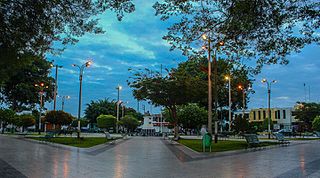
Casma is a city in the Ancash Region, Peru. It is located in the Casma Valley. Its surface has 1 204,85 km².
Peruvian territory was inhabited 14,000 years ago by hunters and gatherers. Subsequent developments include the appearance of sedentary communities that developed agriculture and irrigation, and the emergence of complex socio-political hierarchies that created sophisticated civilizations, technology and monumental construction.

The Norte Chico civilization was a complex pre-Columbian-era society that included as many as thirty major population centers in what is now the Norte Chico region of north-central coastal Peru. The civilization flourished between the fourth and second millennia BC, with the formation of the first city generally dated to around 3500 BC, at Huaricanga, in the Fortaleza area. It is from 3100 BC onward that large-scale human settlement and communal construction become clearly apparent, which lasted until a period of decline around 1800 BC. Since the early 21st century, it has been established as the oldest-known civilization in the Americas.

Chanquillo or Chankillo is an ancient monumental complex in the Peruvian coastal desert, found in the Casma-Sechin basin in the Ancash Department of Peru. The ruins include the hilltop Chankillo fort, the nearby Thirteen Towers solar observatory, and residential and gathering areas. The Thirteen Towers have been interpreted as an astronomical observatory built in the 4th century BC. The culture that produced Chankillo is called the Casma/Sechin culture or the Sechin Complex.

The Casma River which upstream is called Río Grande is a river that crosses northern Casma province in the Ancash Region of Peru. It originates in the Black Mountain Range and drains into the Pacific Ocean. Major tributaries include the Sechín River (right).

Cerro Sechín is an archaeological site in Casma Province of Ancash Region in northern Peru. Dating to 1600 BC, the site was discovered by Peruvian archaeologists Julio C. Tello and Toribio Mejía Xesspe on July 1, 1937. Tello believed it was the capital of an entire culture, now known as the Casma/Sechin culture or Sechin complex. Notable features include megalithic architecture with carved figures in bas-relief, which graphically dramatize human sacrifices. Cerro Sechín is situated within the Sechin Alto Complex, as are Sechin Bajo, and Taukachi-Konkan. There is a small on-site museum. The slabs at Cerro Sechin may represent the central Andes' oldest known monumental sculpture.
The Andean civilizations were complex societies of many cultures and peoples mainly developed in the river valleys of the coastal deserts of Peru. They stretched from the Andes of Ecuador southward down the Andes to northern Argentina and Chile. Archaeologists believe that Andean civilizations first developed on the narrow coastal plain of the Pacific Ocean. The Caral or Norte Chico civilization of Peru is the oldest civilization in the Americas, dating back to 3200 BCE.
The Kotosh Religious Tradition is a term used by archaeologists to refer to the ritual buildings that were constructed in the mountain drainages of the Andes between circa 3000 and c.1800 BCE, during the Andean preceramic, or Late Archaic period of Andean history.
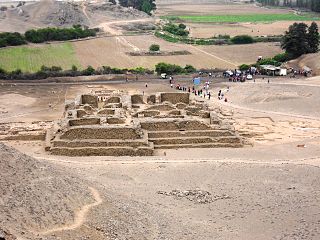
El Paraíso is the modern name of a Late Preceramic (3500–1800 BC) archaeological site located in the Chillón Valley on the central coast of Peru. The site is situated several kilometers north of Lima, the capital of Peru, in the San Martin de Porres District in the Province of Lima. El Paraíso is one of the largest settlements from this period, encompassing over 58 hectares of land.

Sechin Bajo is a large archaeological site with ruins dating from 3500 BCE to 1300 BCE, making it not only one of the oldest centers of civilization in the Western Hemisphere, but also one of the oldest civilization centers on earth. Sechin Bajo is located in the valley of the Sechin River, about 12 kilometres (7.5 mi) from the Pacific Ocean and about 330 kilometres (210 mi) northwest of Lima, Peru. Sechin Bajo is one ruin among many located in close proximity to each other in the valleys of the Casma and Sechin Rivers.
Sechin Alto is a massive architectural complex in Peru belonging to the Early Formative period. It is located in the Casma Province, the Ancash Region, on the left bank of the Sechín River, east of the town of the same name. Other important archaeological sites such as Cerro Sechin and Sechin Bajo are located nearby.
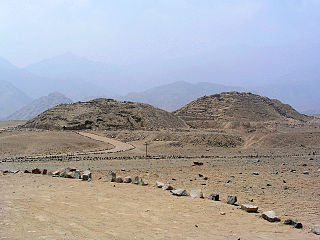
Andean preceramic refers to the early period of human occupation in the Andean area of South America that preceded the introduction of ceramics. This period is also called pre-ceramic or aceramic.
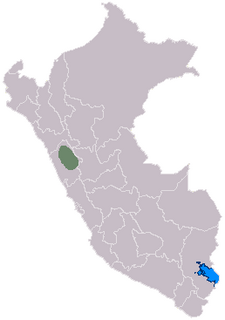
The Recuay culture was a pre-Columbian culture of highland Peru that flourished from 200 BCE to 600 CE and was related to the Moche culture of the north coast. It is named after the Recuay District, in the Recuay Province, in the Ancash Region of Peru.
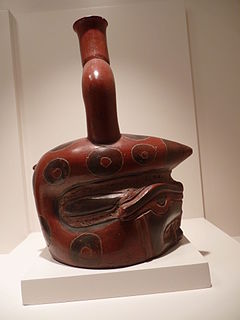
Caballo Muerto is an archaeological complex located on the northern coast of Peru, in the Moche Valley, in the Laredo District of La Libertad Region. It represents a series of mound sites that span both the Initial Period and the Early Horizon.

Las Haldas or Las Aldas is a large archaeological complex from before and during the initial ceramic period of Peru. Las Haldas is located on the Pacific coast approximately 300 kilometres (190 mi) north of Lima and about 20 kilometres (12 mi) south of the Casma river valley, noted for the extensive ruins of the Casma/Sechin culture. For most of its history Las Haldas, a coastal community, coexisted with the inland agricultural communities in the Casma River Valley.

The Casma–Sechin culture of Peru refers to the large concentration of pre-historic ruins in the valleys of the Casma River and its tributary the Sechin River and along the nearby coast of the Pacific Ocean. The ruins include major archaeological sites such as Sechin Bajo, Sechin Alto, Cerro Sechin, Mojeque, Chankillo, and Taukachi-Konkan, as well as other smaller sites. Most of these inland sites are found in the river valleys about 20 kilometres (12 mi) distant from the ocean. The seaside sites of Huaynuná and Las Haldas are found about 20 kilometres (12 mi) north and south of the mouth of the Casma River on the coast.
Richard Lewis Burger, Ph.D., is an archaeologist and anthropologist from the United States. He is currently a professor at Yale University and holds the positions of Charles J. MacCurdy Professor in the Anthropology Department, Chair of the Council on Archaeological Studies, and Curator in the Division of Anthropology at the Peabody Museum of Natural History. He has carried out archaeological excavations in the Peruvian Andes since 1975, publishing several books and many articles on Chavin culture, a pre-Hispanic civilization that developed in the northern Andean highlands of Peru from 1000 BC to 400 BC. Burger is married to Lucy Salazar, a Peruvian archaeologist and long time collaborator on many researach projects. His former doctoral student Sabine Hyland has become well-known as an Andean anthropologist.













